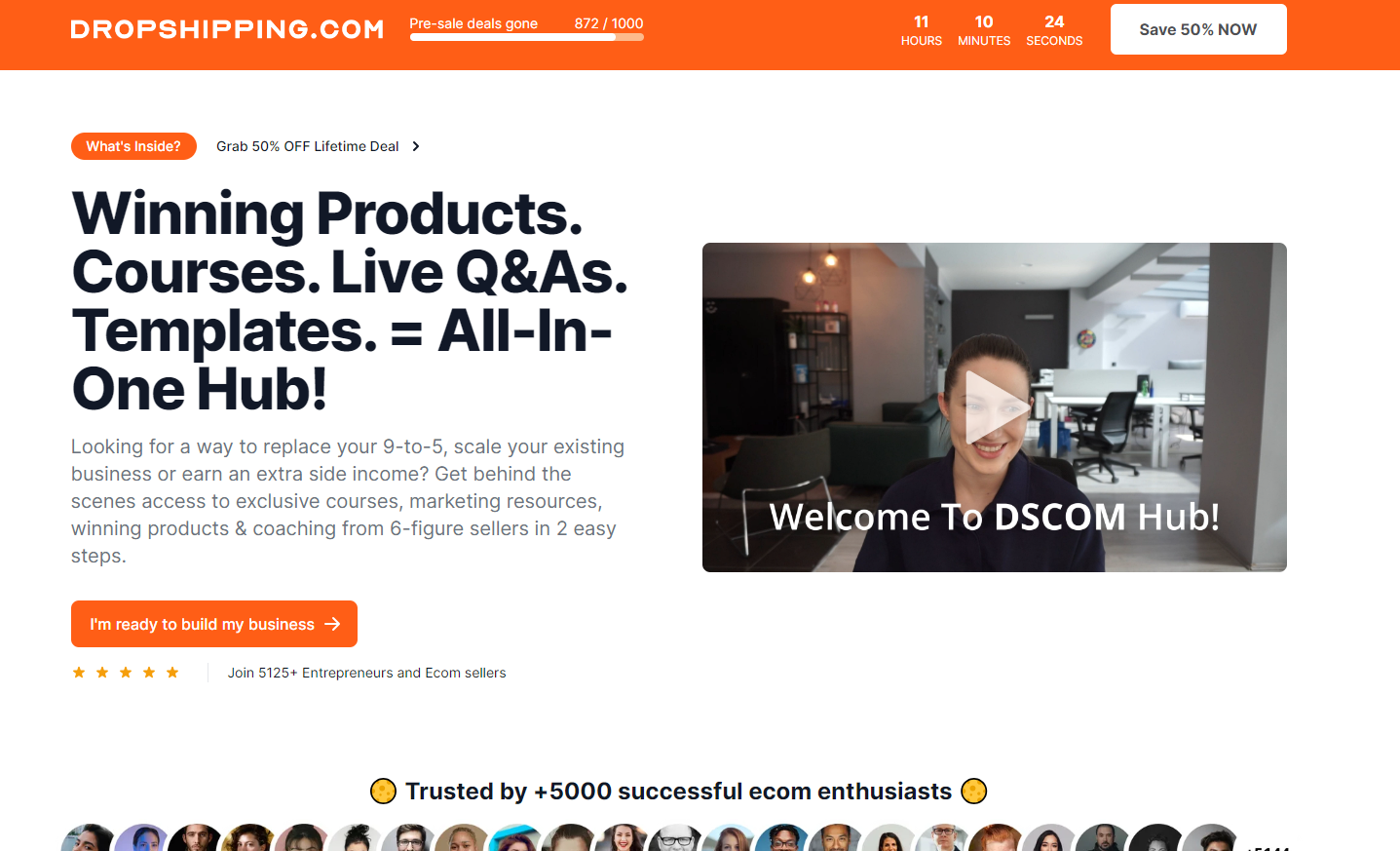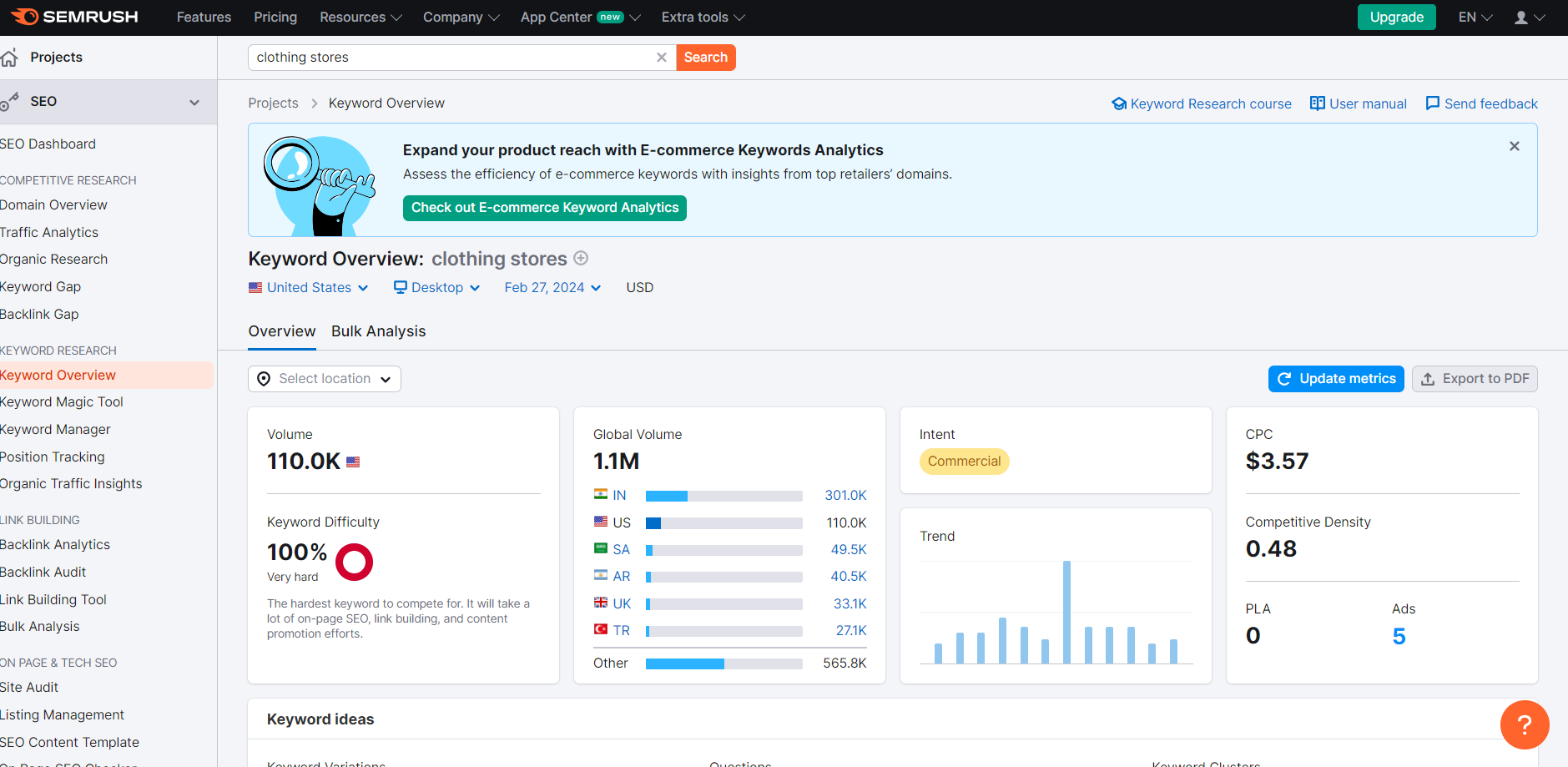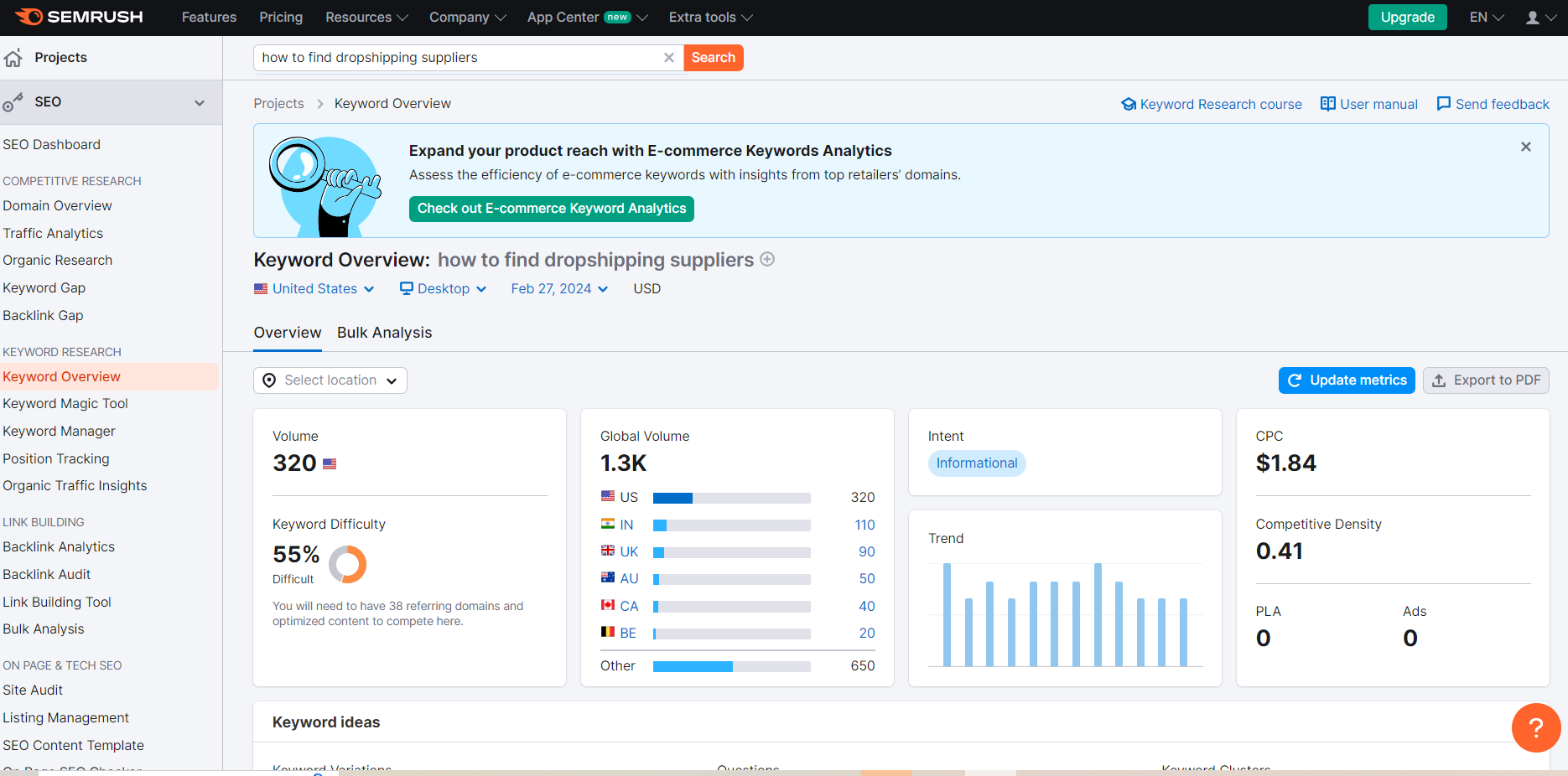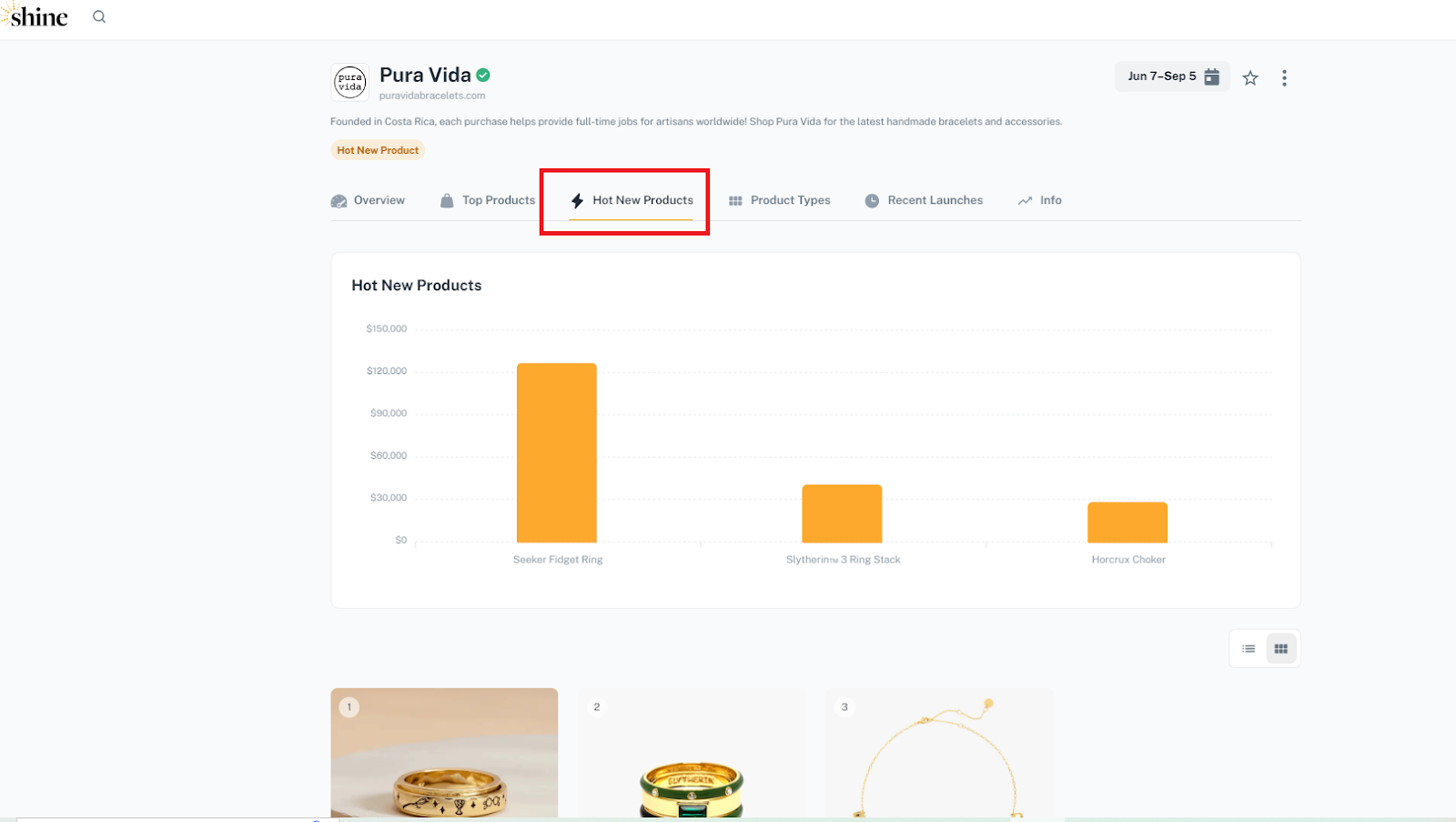How To Get More Visitors On Your Ecom Store From Google
I'm looking for...
In today’s digital marketplace, having a dropshipping site is just the beginning. The real challenge lies in expanding its dropshipping store reach on Google, where millions of potential customers search for products every day.
Effective web design and ecommerce SEO strategies are pivotal in navigating this competitive landscape. They not only enhance your site’s visibility. Also, they ensure that it ranks higher in search results, attracting more traffic and, ultimately, converting visits into sales.
This article delves into proven strategies to amplify your online presence on Google, covering essential areas such as SEO, local search, Google My Business (GMB) local inventories, comparison sites, and affiliate networks.
By implementing these tips, you can significantly increase your dropshipping site’s reach and sales.
Create Your Online Store in just 5 Minutes – For Free
Pick your niche, our AI builds your store, add 10 winning products and we teach you how start selling today. Start picking your niche
Understanding Ecommerce SEO for Dropshipping
Ecommerce SEO is pivotal for the success of any online store. However, it is especially in the dropshipping model where competition can be intense.
Thus, this specialized branch of SEO focuses on optimizing product listings and categories to not just improve visibility but also drive sales.
For dropshipping businesses, understanding your target market’s search behavior is crucial for increasing organic sales.
This includes emphasizing keywords that indicate buying intent, which is essential for attracting potential customers actively looking to purchase.
So, if dropshipping store reach on Google is important for you, here’s what to consider.
Key Considerations for Dropshipping SEO:
- Optimized Product Listings: Given the nature of dropshipping, where inventory can rapidly change, it’s vital to ensure that each product listing is optimized with the right keywords. This optimization isn’t just about visibility; it’s about connecting with consumers ready to buy.
- Adaptive SEO Strategies: Dropshipping allows for a diverse range of products. As such, your SEO strategy must be flexible and adaptive, focusing on the dynamic nature of your inventory and the latest trends in consumer search behavior.
Leveraging Search Intent for Ecommerce Success: The Case of Selling Socks
Optimizing an ecommerce site for selling socks requires a nuanced understanding of search intent, distinguishing between terms with commercial intent and those seeking information.
So, here’s what to keep in mind when trying out for dropshipping store reach on Google.
 Including Targeted Search Terms
Including Targeted Search Terms
Incorporating targeted search terms such as “buy wool socks online,” “athletic socks for running,” and “eco-friendly bamboo socks” directly appeals to potential buyers ready to make a purchase.
Thus, each keyword targets a specific market segment, ensuring that the site’s offerings meet the varied needs and preferences of consumers.
On the other hand, terms like “how to knit socks” or “best material for socks” indicate a non-commercial intent, where users are primarily looking for information.
While these users might not be ready to buy immediately, they represent a valuable audience. Plus, this helps you with the dropshipping store reach on Google.
 Provide Engaging Content
Provide Engaging Content
By providing engaging content that addresses these informational queries through blog posts, guides, or tutorials, an ecommerce site can establish itself as an authoritative source on all things related to socks.
This strategy not only broadens the site’s reach but also builds trust with visitors, gradually nudging them towards making a purchase in the future.
For example, Dropshipping.com is a great educational hub that actually serves its customers with every kind of content like, blog posts, courses, guides, tutorials, podcasts, videos, etc. So, there’s something for everyone.

Understanding and leveraging the intent behind search queries allows ecommerce sites to tailor their content and SEO strategies effectively.
By catering to both immediate buying needs and informational searches, a site can enhance its visibility, attract a wider audience, and ultimately, increase sales in the competitive online marketplace.
 Integrating Keywords
Integrating Keywords
- Strategic Keyword Placement: Incorporating relevant keywords into your website, from product descriptions to meta titles and headers, is fundamental. For a dropshipping site, this means choosing keywords that not only have high search volumes. And, it aligns with the specific products you’re offering. Also, it includes the queries your potential customers are using.
- Product-Specific Keywords: Unlike traditional SEO, ecommerce SEO for dropshipping must account for the wide variety of products offered.
- This means identifying and using keywords that accurately describe each product. Hence, it enhances the likelihood of your site appearing in front of the right audience at the right time.
For example, you can check on keyword search volume and other valuable information using SEO tools like Semrush. So, let’s try it out.
Hence, I will use the keyword “clothing stores” as I am doing research for my clothing dropshipping business.
So, as you can see, this is a great search volume. However, keep in mind that getting a dropshipping store reach on Google based on this keyword is very hard.

Effective Keyword Research Strategies for Dropshipping
Keyword research is the backbone of any successful ecommerce SEO strategy, especially for dropshipping businesses. The goal is to identify not just any keywords, but those that reflect the specific queries used by your target audience.
This includes a focus on long-tail keywords, which, due to their specificity, can dramatically increase your site’s visibility and attract highly targeted traffic.
Keyword Research Tools
Utilize these tools to discover long-tail keywords that potential customers might use when searching for your products:
- Google Keyword Planner (free version will give you a range of search volume)
- SEMrush
- Ahrefs
- Keyword Shitter
For instance, Ahrefs is a really good tool for SEO. It helps me check out my website’s traffic and how well it’s doing. Plus, I can see what my competitors are up to too.

When you study this info, you can smartly plan how to make your dropshipping business and marketing better.
Long-Tail Keywords
- Finding Long-Tail Keywords: These keywords are often more specific and less competitive, making them invaluable for a dropshipping business aiming to stand out in a crowded market.
- Application: Incorporate these long-tail keywords into product titles, descriptions, and even your blog content to address specific customer queries and needs. This approach not only improves your site’s SEO. Also, it enhances user experience by making it easier for customers to find exactly what they’re looking for.
For example, let’s make an analysis of the keyword “how to find dropshipping suppliers“.
Thus, the keyword is specific, since customers are strictly searching for dropshipping suppliers. So, if I type in the keyword in Semrush, you can see that the keyword difficulty is slightly lower than in the previous example.

Plus, if I try to be even more specific, like“how to find dropshipping suppliers in New York“, I will have a whole different scenario- lower keyword difficulty, more specific, lower search volume.
Managing Product Variations
 Unified Listings vs. Separate Listings
Unified Listings vs. Separate Listings
When dealing with products that come in multiple variations (e.g., different colors or sizes), it’s generally better to consolidate these variations into a single listing.
This prevents your products from competing against each other for the same search terms. Plus, it can help you with the dropshipping store reach on Google.
However, if keyword research indicates a substantial search volume for specific variations (e.g., 500 searches per month for a particular color), creating separate listings may be beneficial to capture that targeted traffic.
 Keyword Strategy for Variations
Keyword Strategy for Variations
For products with significant search volumes for variations, tailor the SEO strategy to include specific keywords for each variation. This ensures that your listings are optimized to capture the diverse search intent of your audience.
Optimizing for Competitiveness
 Competitive Analysis
Competitive Analysis
Regularly analyze your competitors’ keyword strategies to identify gaps and opportunities.
So, understanding which keywords are driving traffic to their sites can provide insights into how to adjust your own keyword strategy. Thus, there are numerous competitor spy tools.
For example, Commerce Inspector is a handy tool you can install on your web browser, particularly if you use Google Chrome on a Mac or Windows computer. It acts like a spy for your business stats.

With Commerce Inspector, Shopify shop owners can sneak a look at what other online stores are doing, all in a fair way.
This way, you can check out your rivals’ top-selling products, how many they’ve sold, what new items they’ve added, and even stay updated on their ads and sales patterns.
 Continuous Optimization
Continuous Optimization
SEO is an ongoing process. Continually refine and update your keyword strategy based on performance data and market trends to ensure your dropshipping site remains competitive and visible to your target audience.
Focusing on these tailored strategies for Ecommerce SEO and effective keyword research, dropshipping businesses can significantly enhance their online visibility and sales potential. And, this is crucial for dropshipping store reach on Google.
These approaches emphasize the unique aspects of dropshipping, such as the need for adaptive SEO strategies and the importance of detailed keyword research to navigate the competitive online marketplace successfully.
Optimizing Your Dropshipping Site for Google and Users
Optimizing your dropshipping site for Google goes beyond mere keyword placement. It encompasses a holistic approach to ecommerce web design and on-site SEO strategies that enhance user experience and site performance.
Ecommerce Web Design Best Practices
Next, if you want to build a dropshipping store reach on Google, here are other important things to consider.
 User-Friendly Navigation
User-Friendly Navigation
Design your website with clear, intuitive navigation to help visitors find what they’re looking for with minimal effort. This includes well-organized categories, a search function, and a clean layout.
 High-Quality Images and Descriptions
High-Quality Images and Descriptions
Use high-quality product images and detailed descriptions incorporating keywords. This not only aids in SEO but also improves user engagement and trust.

 Responsive Design
Responsive Design
Ensure your website is mobile-friendly. With the increasing prevalence of mobile shopping, a responsive design is essential for reaching a broader audience and improving your site’s ranking on Google.
Site Structure Optimization Using Mind Map Software
Optimizing your site structure is crucial for both user experience and SEO. A logical and well-organized site structure helps Google’s bots crawl and index your pages efficiently, which is essential for achieving higher rankings in search results. Using mind map software like MindMup can significantly streamline this process.
Mind Map Software for Planning

- Visualizing Site Structure: MindMup allows you to visually plan your site’s hierarchy, making it easier to understand and organize. You can create a central node for your homepage and branch out nodes for main categories and subcategories, visually laying out the structure of your site.
- Keyword Organization: Incorporating your targeted keywords into the mind map’s nodes helps in assigning them to the most relevant pages. This method ensures that your content is aligned with user search intent and SEO goals, making your website more likely to attract qualified traffic.
- Efficiency in Reorganization: One of the key benefits of using mind map software is the ease with which you can reorganize your site’s structure. As your site grows or your strategy shifts, you can quickly adjust the nodes to reflect changes, ensuring your site structure remains optimized for both users and search engines.
By leveraging mind map software for site structure planning, you can create a more effective and SEO-friendly website architecture. This approach not only aids in the initial design phase but also simplifies ongoing site management and optimization.
Speed Optimization with Advanced Tools and Techniques
Optimizing your site’s speed is crucial for improving user experience and boosting your SEO rankings. Slow loading times not only deter visitors but also negatively impact your site’s visibility on search engines.
To address these challenges, employing advanced tools like the Asset Cleanup plugin for WordPress and utilizing Chrome’s Coverage tool can offer significant benefits. Here’s a detailed approach to leveraging these resources for speed optimization:

Using the Asset Cleanup Plugin
Want to achieve dropshipping store reach on Google? Let’s see how this plugin can help.
 Unload Unnecessary Files
Unload Unnecessary Files
Asset Cleanup scans your pages and identifies files that are not necessary for certain pages to function. This allows you to selectively disable scripts, styles, and other assets that aren’t being used, effectively reducing the load time of your site.
 Optimization Features
Optimization Features
Beyond unloading unused files, Asset Cleanup offers a suite of optimization features.
It supports standard caching techniques such as minification (reducing the size of your files by removing unnecessary characters), combining files to reduce the number of requests, and deferring non-critical resources to ensure they don’t slow down the initial load.
 Granular Control
Granular Control
One of the standout features of Asset Cleanup is its ability to defer loading files on a per-page basis.
This granular control allows you to tailor the loading behavior of scripts and styles based on the specific needs of each page. However, it’s crucial to test your site after applying these settings to ensure that functionality remains intact.
Leveraging Chrome’s Coverage Tool

- Identify Unused Code: The Coverage tool, accessible via Chrome’s DevTools, provides a real-time analysis of the code used while your page loads and interacts with users. To use it, open Chrome’s inspect element, navigate to the three dots on the right, select More Tools, and then choose Coverage. Refreshing the page and interacting with it will reveal which files are in use and which aren’t.
- Streamlining Your Assets: With the data from the Coverage tool, you can pinpoint CSS and JavaScript that are not being utilized. This insight allows you to make informed decisions about which files can be unloaded, further optimizing your site’s performance.
- Complementary Optimization Strategies:
- Image Optimization: Ensure images are properly sized and compressed to reduce their impact on load times. Tools like Adobe Photoshop or online compressors can significantly reduce file sizes without compromising quality.
- Leverage Browser Caching: Set appropriate expiry times for your resources. This instructs browsers to reuse cached versions of files rather than downloading them again on subsequent visits, speeding up load times for repeat visitors.
Best Practices:
- Regularly Monitor Performance: Use Google PageSpeed Insights alongside these tools to regularly assess your site’s speed and identify areas for improvement.
- Iterative Optimization: Speed optimization is an ongoing process. You should enable each setting/optimization one by one to ensure you don’t break anything on site, check after each setting is applied and test your site.
Integrating the Asset Cleanup plugin and utilizing Chrome’s Coverage tool, you can significantly enhance your site’s loading speed. These tools provide valuable insights into how resources are utilized on your site and offer powerful features for optimizing performance. Remember, the goal is to create a balance between functionality and speed, ensuring a seamless user experience while maximizing SEO potential.
Leveraging Local Search, GMB, and Google Shopping for Dropshipping Success
For dropshipping businesses targeting local markets, mastering local SEO and utilizing Google My Business (GMB), along with Google Shopping, can significantly enhance visibility and sales. Here’s a concise guide on optimizing these platforms:
- Optimize for Local Keywords: Embed location-based keywords in your site’s content and meta tags to bolster visibility in local search results.
- Claim and Optimize Your GMB Listing: Ensure your GMB profile is detailed and accurate, including managing reviews and adding high-quality images to boost your local search presence.
Expanding Reach with Google Shopping Listings
The integration of local inventories on GMB and free Google Shopping listings via Google Merchant Center offers a unique opportunity to display your products prominently on Google.
For those using WooCommerce, the Product Feed PRO for WooCommerce plugin by AdTribes simplifies the process of syncing your inventory with Google Merchant Center.

So, follow these steps to leverage these tools effectively and boost dropshipping store reach on Google:
- Set Up Google Merchant Center Account: Begin by setting up your account and verifying your business details.
- Sync Your Product Inventory: Utilize the Product Feed PRO for the WooCommerce plugin. This plugin automates the creation and optimization of your product feed. Thus, it ensures your inventory is accurately represented on Google Merchant Center.
- Optimize Product Listings: Incorporate relevant keywords and high-quality images. Make sure your product information, including pricing and availability, is accurate.
- Activate Google Shopping Listings: Enable free listings in the Google Merchant Center to showcase your products on Google Shopping.
- Add Local Inventory Products: For businesses with physical stock or a local presence, adding local inventory is important. Hence, it ensures your products are visible in both local finder and Google Shopping local inventory ads. So, follow Merchant Center guidelines to submit your local inventory feed, indicating store codes, product availability, and prices at each location.
- Monitor and Optimize: Regularly review the performance of your listings. Thus, adjust product titles, descriptions, and pricing as needed to improve visibility and attract more customers.
This comprehensive approach ensures a competitive edge in the digital marketplace, driving both local and online customer engagement.
Utilizing Comparison Sites and Affiliate Networks
In the competitive ecommerce landscape, leveraging comparison shopping engines (CSEs) and affiliate networks can boost your dropshipping site’s visibility and sales.
However, the effectiveness of these strategies in a dropshipping model hinges on having good product margins.
Dropshipping typically involves thinner margins due to supplier fees and higher product costs. Thus, it’s crucial to select products that offer competitive prices yet still provide a healthy margin to cover the commissions associated with CSEs and affiliate networks.

To benefit from these platforms, dropshippers should focus on products with less price competition. Also, they can negotiate better terms with suppliers, and ensure their listings are optimized for maximum visibility.
So, success in integrating these tools into your dropshipping business depends on a careful balance of product selection, pricing strategy, and operational efficiency.
 Comparison Shopping Engines
Comparison Shopping Engines
- What Are They? CSEs are websites where shoppers can compare products from different sellers based on price, reviews, features, and more. Examples include Google Shopping, PriceGrabber, and Shopzilla.
- Why Use Them? Listing your products on CSEs can dramatically increase your visibility to motivated buyers. These platforms cater to users already in the decision-making phase, increasing the likelihood of conversions.
- How to Leverage CSEs: Optimize product listings with high-quality images, detailed descriptions, and competitive pricing. Ensure your ecommerce web design facilitates an easy checkout process to capitalize on the traffic from CSEs.
 Affiliate Networks
Affiliate Networks
- What Are They? Affiliate networks connect online merchants with affiliate marketers who promote products. However, this is in exchange for a commission on sales generated through their referrals.
- Why Use Them? They expand your reach beyond your immediate audience, tapping into the followers of influencers and content creators in your niche.
- How to Leverage Affiliate Networks: Choose networks that align with your product niche and have a reputable pool of affiliates. Provide affiliates with all the necessary tools and information to effectively market your products, including banners, product feeds, and promotional materials.
 Content Marketing and Link Building Strategies
Content Marketing and Link Building Strategies
Creating valuable content and building a robust backlink profile are critical components of a comprehensive ecommerce SEO strategy. These elements not only enhance your site’s authority and relevance in Google’s eyes but also drive organic traffic and engage potential customers.
 Content Marketing
Content Marketing
- Blog Posts and Guides: Create informative content that addresses your target audience’s needs and queries. Incorporate relevant keywords, including long-tail phrases, to improve your content’s visibility on Google.
- Videos and Tutorials: Product demonstrations, how-to videos, and tutorials can significantly boost engagement and time spent on your site, positively influencing your SEO.
- Leverage User-Generated Content: Encourage reviews, testimonials, and social media mentions. User-generated content can enhance credibility and provide fresh, keyword-rich content for your site.

 Link Building Strategies
Link Building Strategies
- Guest Blogging: Write articles for reputable sites in your industry to get quality backlinks and increase your site’s visibility.
- Influencer Collaborations: Partner with influencers for product reviews or sponsored content. Their endorsements can result in valuable backlinks and increased traffic.
- Participate in Online Communities: Engage in forums and communities related to your niche. Share your expertise and include links to your content when relevant, driving both traffic and backlinks.
 Enhancing Performance Monitoring and Adjustments with Advanced Tools
Enhancing Performance Monitoring and Adjustments with Advanced Tools
The key to sustained success in expanding the reach of your dropshipping site lies in meticulous performance tracking and the agility to make informed adjustments.
Leveraging the right tools and staying abreast of the latest analytics trends are critical components of this process. Hence, this helps you achieve dropshipping store reach on Google.
 Performance Tracking with Google Tools
Performance Tracking with Google Tools
- Google Search Console: This free tool is indispensable for monitoring your site’s presence in Google search results. It provides detailed reports on your site’s visibility, including the performance of specific keywords and how often your site appears in search results. Google Search Console is also excellent for monitoring your site’s backlink profile, offering insights into the external links pointing to your site.
- Google Analytics and GA4: Google Analytics offers comprehensive tracking of traffic sources, user behavior, and conversion rates. With the transition to GA4, users are provided with a more integrated view of how users interact with their site across devices. Building conversion tracking into Google Analytics allows you to measure the effectiveness of your marketing efforts accurately and identify the most fruitful sources of traffic.
- Learning Curve and Resources: Transitioning from the old version of Google Analytics to GA4 involves a learning curve. For those looking to master advanced tracking features, Analytics Mania offers easy-to-understand guides that cover a wide range of topics, from basic setup to sophisticated tracking configurations. These resources are invaluable for ecommerce site owners aiming to leverage data for strategic decision-making.
 Integrating Advanced Tracking
Integrating Advanced Tracking
- Beyond basic performance metrics, integrating advanced tracking solutions from Google Analytics and insights from Google Search Console can reveal deeper trends and patterns in user behavior and SEO performance. This holistic approach to data analysis enables more nuanced adjustments to your marketing and SEO strategies, maximizing the impact of your efforts.
SEO Audits and Strategy Adjustments with Comprehensive Tools
Regular SEO audits are indispensable for pinpointing issues that could impede your dropshipping site’s performance. Integrating tools like SEMrush, Ahrefs, and the powerful Screaming Frog SEO Spider into your audit process can significantly enhance your site’s SEO health.
Comprehensive SEO Tools
- SEMrush and Ahrefs: These platforms offer in-depth insights into keyword rankings, backlink profiles, and competitive analysis. They are essential for understanding your site’s position in the SEO landscape and identifying opportunities for improvement.
- Screaming Frog SEO Spider: Recognized as one of the best tools on the market, Screaming Frog specializes in fast and comprehensive SEO site audits. The SEO Spider tool allows you to crawl your website’s URLs to identify common SEO issues, providing a solid foundation for your audit efforts. Notably, Screaming Frog offers a free version that can crawl up to 500 pages, making it accessible for sites of various sizes to start optimizing their online presence.
SEO Audits
- SEO audits should focus on identifying broken links, slow loading times, and unoptimized content. Utilizing the detailed reports generated by SEMrush, Ahrefs, and Screaming Frog can uncover these and other issues, such as duplicate content or missing alt tags, which can affect your site’s search engine rankings.
Strategy Adjustments
- Insights from these tools are crucial for making informed adjustments to your SEO strategies. Whether it’s tweaking your content creation approach, targeting new keywords based on emerging trends, or refining your link-building tactics, the goal is to remain adaptable. Continuous refinement, based on accurate and comprehensive data, ensures that your site not only maintains its current reach but also experiences growth.
Utilizing Advanced Tools for Informed Decision-Making
- The combination of Google Analytics, Google Search Console, SEMrush, Ahrefs, and Screaming Frog provides a robust toolkit for any ecommerce site owner. These tools collectively offer a 360-degree view of your site’s SEO performance, from basic traffic analysis to advanced technical audits.
- Leveraging this comprehensive suite of tools allows for a holistic approach to SEO, enabling site owners to make data-driven decisions that propel their sites forward in a competitive digital marketplace.
Using advanced tools like SEMrush, Ahrefs, Screaming Frog, Google Analytics, and Google Search Console allows dropshipping site owners to effectively audit, monitor, and refine their SEO strategies. This integrated approach enhances online visibility and user experience, enabling data-driven adjustments for sustained growth in a competitive digital marketplace.
Maximizing Your Dropshipping Site’s Reach on Google
In conclusion, the journey to expanding your dropshipping store reach on Google involves a strategic mix of leveraging proper site structure, keyword research, and employing robust content marketing and link-building strategies.
You can significantly enhance your site’s visibility and drive sales. Thus, this can be done by continuously monitoring and refining your approach with advanced SEO tools and analytics.
This holistic approach to ecommerce SEO ensures not just a temporary boost in traffic. Plus, it secures the foundation for your dropshipping business’s enduring success.
So, embrace these strategies to navigate the competitive landscape of online retail. Also, watch your dropshipping venture thrive in the digital ecosystem.
















![The Top 21 3PL Companies Compared [2025 List & Guide]](https://images.weserv.nl/?url=https://prod-dropshipping-s3.s3.fr-par.scw.cloud/2024/03/Frame-3922469.jpg&w=420&q=90&output=webp)